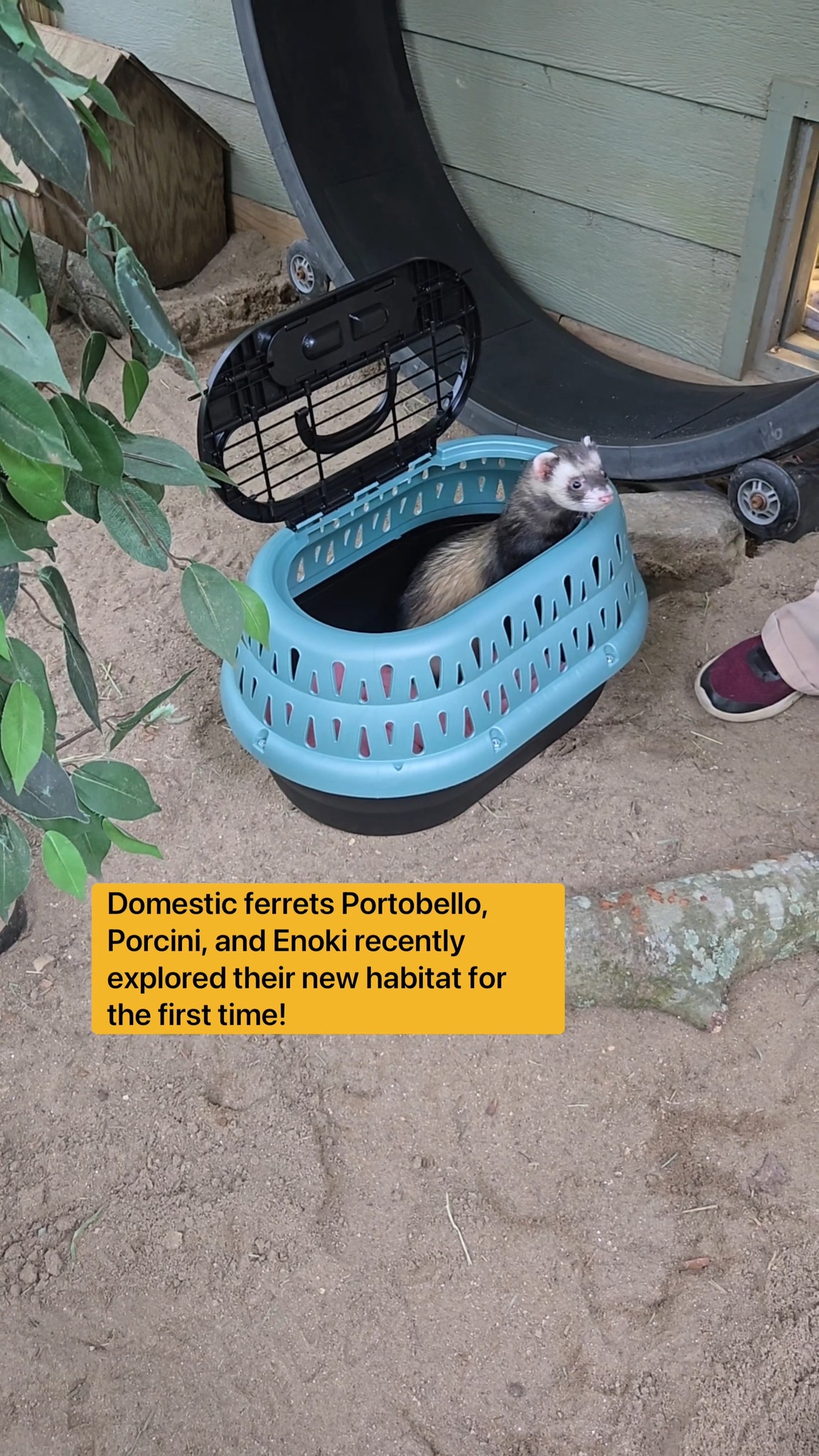- Importance of Domestic Ferrets in Education and Conservation
- Overview of Enoki, Portobello, and Porcini’s Backgrounds
- Behavioral Traits and Characteristics of Domestic Ferrets
- Habitat and Care Needs for Domestic Ferrets
- The Role of Ferrets in Ambassador Animal Programs
Domestic ferrets Enoki, Portobello, and Porcini recently transitioned to their new habitat, coming from a ferret rescue organization. These animals, previously kept as pets, will actively participate in educational outreach as part of an initiative aimed at fostering awareness about wildlife and conservation. The ferrets will join other Ambassador Animals in school visits and field trip encounters. Understanding their behaviors and needs is critical for ensuring they thrive in their new roles.
Domestic ferrets have gained popularity in various settings due to their playful nature and social interactions. When ferrets are included in educational programs, they serve as bridges to engage people, particularly children, in discussions about animal care, wildlife conservation, and responsible pet ownership. Ambassador Animals provide a tangible connection to wildlife, allowing individuals to appreciate and respect different species. By observing the interactions with ferrets, audiences can garner insights on ethical treatment and understanding of animal behavior.
Enoki, Portobello, and Porcini exemplify the diversity found within domestic ferrets. Enoki is the most adventurous, demonstrating a bold spirit by being the first to explore new environments, like the giant wheel in their new habitat. This curiosity is essential, as it not only aids in their adaptation process but also showcases their natural inquisitiveness to visitors. On the other hand, Portobello is more reserved, showing caution as he acclimates to his new surroundings. This behavioral variance highlights how personality traits can differ even in animals of the same species, emphasizing the importance of individualized care and understanding.
Portobello’s careful approach offers a learning opportunity. Visitors interacting with him can appreciate the importance of patience and gentleness with animals that are timid or cautious. Enoki’s curiosity, contrasted with Portobello’s hesitance, reflects how domestic ferrets, while similar in many ways, can possess distinct personalities that influence their behaviors and interactions. Porcini, the third ferret, represents a middle ground, balancing playfulness and exploration with calmness, allowing visitors to see a broader spectrum of domestic ferret behaviors.
Behaviorally, domestic ferrets exhibit a variety of traits that make them intriguing pets and educational ambassadors. They are crepuscular and often active during dawn and dusk, though they spend a substantial amount of time sleeping throughout the day and night. This sleep cycle is vital to keep in mind for caretakers to ensure they engage the ferrets when they are most active. During their wakeful periods, ferrets can display extraordinary agility and energy, darting around their environment, performing acrobatic flips, and engaging in playful chases with toys or their fellow ferrets. This lively behavior captures the attention of audiences and showcases the importance of adequate exercise and stimulation for social animals.
Understanding the social structure of ferrets is essential, as they thrive in the company of other ferrets or animals. They communicate through a range of vocalizations, body language, and playful interactions. Educators can use these traits to teach about animal instincts and the importance of socialization for domesticated species. Fostering environments where animals can express their natural behaviors enhances their well-being, making it critical for educators and caretakers to provide ample opportunities for ferrets like Enoki, Portobello, and Porcini to engage with their surroundings.
The habitat for these domestic ferrets must cater to various needs. A suitable living environment includes spacious enclosures with safe hiding spots, climbing structures, and interactive toys that stimulate both their physical and mental capabilities. The ferrets need an area where they can run, explore, and engage in activities that mimic their natural instincts. Among their requirements, a clean and secure enclosure is vital for their health, as ferrets are prone to certain health issues linked to poor living conditions. Regular cleaning and maintenance of their habitats help avoid the risks of disease and infection.
Dietary needs also play a crucial role in maintaining the health of domestic ferrets. They are obligate carnivores, which means their diet should consist primarily of high-quality proteins and fats. Caretakers must be vigilant in selecting nutritious food, ensuring it includes animal-based ingredients that cater to their unique dietary requirements. Proper nutrition is vital for their energy levels and overall well-being, as poor dietary choices can lead to health complications.
Ferrets also require routine veterinary care to manage their health effectively. Regular check-ups, vaccinations, and preventive measures against common ferret ailments, such as adrenal gland disease, are essential. Education on these health aspects prepares potential ferret owners to provide the best care possible. Educators can leverage the experiences of Enoki, Portobello, and Porcini to illustrate the responsibilities involved in pet ownership and the importance of regular veterinary care.
The transition of Enoki, Portobello, and Porcini to their new habitat serves as a significant educational opportunity for both the ferrets and the audience. Their integration into ambassador programs aids in highlighting the value of animal care, welfare, and conservation. As they participate in school visits and field trips, students develop a more profound respect for animals and their needs, fostering a generation that values ethical interaction with wildlife and domestic pets alike.
Furthermore, the ambassador role enriches participants’ journeys by emphasizing ecological awareness. By engaging with animals like Enoki, Portobello, and Porcini, children learn about habitats, ecosystems, and the consequences of human actions on wildlife. Each encounter facilitates discussions about conservation and responsible stewardship of the environment, encouraging a sense of duty to protect animal habitats.
In the context of environmental education, it is essential to recognize the significance of ferrets and their role within the larger ecosystem. They contribute to maintaining ecological balance through their behaviors and interactions, even in domesticated settings. By informing individuals about the interconnectedness of species, caretakers inspire broader conservation efforts, emphasizing how pet ownership can align with responsible environmental practices.
As ferrets advance in their roles, the knowledge shared through educational interactions cultivates not only an appreciation for these inquisitive creatures but also a commitment to wildlife conservation. Enoki, Portobello, and Porcini embody the essential attributes of ambassador animals, representing the push for a heightened awareness of animal welfare and environmental conservation in our communities.
The journey of Enoki, Portobello, and Porcini is just beginning. Their adaptation to a new habitat marks an essential step in their lives, serving as a platform for educational endeavors that will undoubtedly impact future generations. By showcasing the unique personalities and behaviors of these domestic ferrets, we can inspire compassion and awareness in individuals, leading to a brighter future for both pets and wildlife. Through meaningful interactions that emphasize the crucial link between animals and humans, we pave the way for enhanced conservation efforts and a more informed society regarding pet care and ethical animal treatment.
*****
Source Description
Domestic ferrets Enoki, Portobello, and Porcini recently moved into their new habitat! They come to us from a ferret rescue and are previous pets. Portobello is the most cautious, taking the longest to leave his crate and explore his environment, while Enoki is the bravest and the first to check out the giant wheel. These three domestic ferrets will be joining other Ambassador Animals in school visits and field trip encounters. Although ferrets sleep a good portion of the day and night, if you catch them during a wakeful period, they are quite amazing little characters! – Becky Y., Curator of Ambassador Animals (video: Becky Y.)


